Human Resource Management Assignment: Employee Induction Manual
VerifiedAdded on 2022/12/16
|16
|4351
|91
Report
AI Summary
This report analyzes an employee induction manual, recruitment, and HR practices within Unilever, a multinational consumer goods company. The report begins with an introduction to the organization, including its mission, purpose, and business objectives. It then explores the key roles and responsibilities of the HR function, including recruitment and selection, development and training, compensation, and employee relations. The report assesses Unilever's approach to workforce planning, recruitment and selection, development and training, and performance management. It examines different methods used in HR practices, such as job descriptions, skill inventories, and multistep recruitment. The report also delves into the importance of talent management in achieving business objectives and the significance of employee induction. Finally, it provides an overview of performance management and reward systems, and flexible working practices. The report is based on the assignment brief which covers topics like employee induction, recruitment, and selection within the context of HRM.
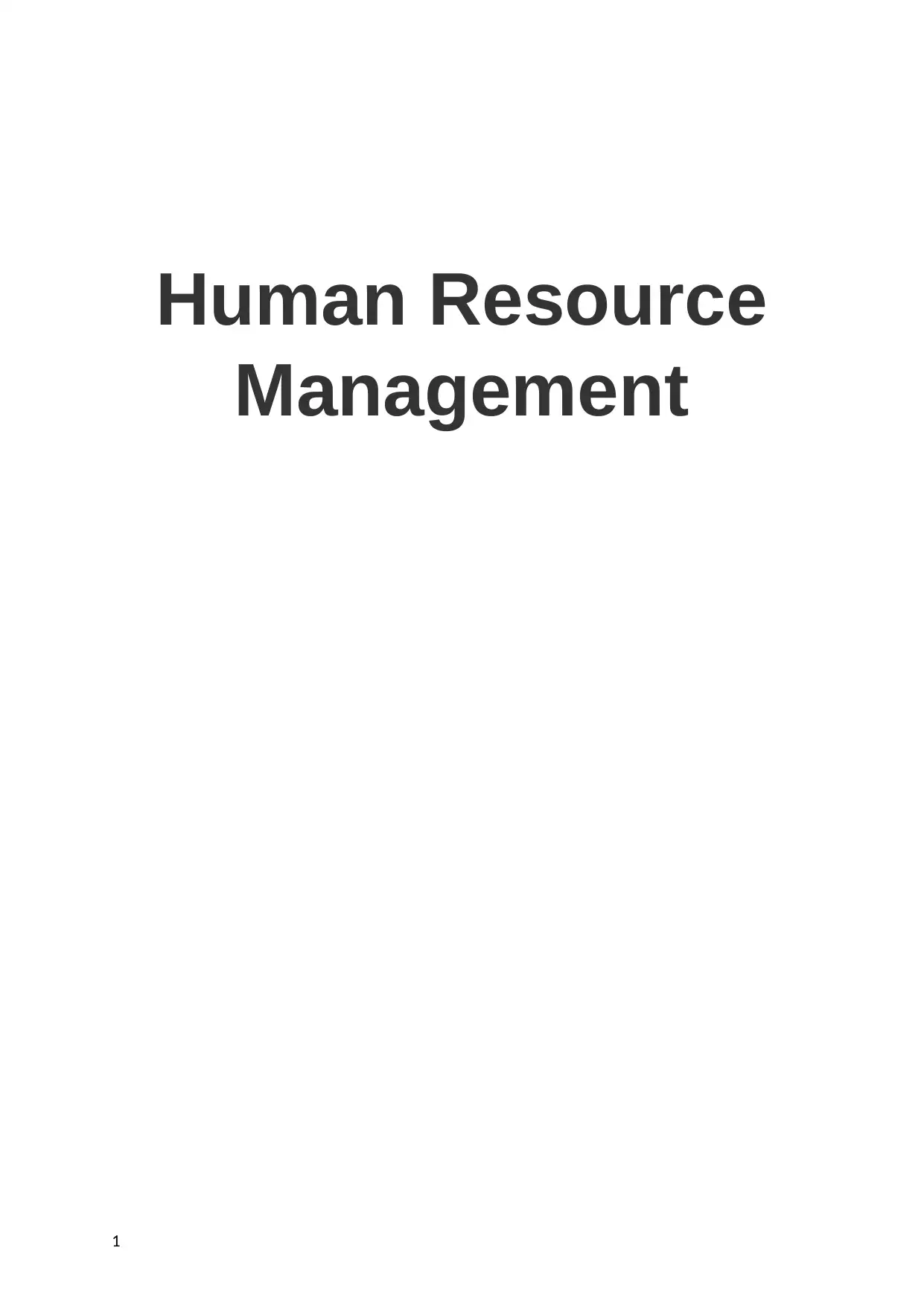
Human Resource
Management
1
Management
1
Paraphrase This Document
Need a fresh take? Get an instant paraphrase of this document with our AI Paraphraser
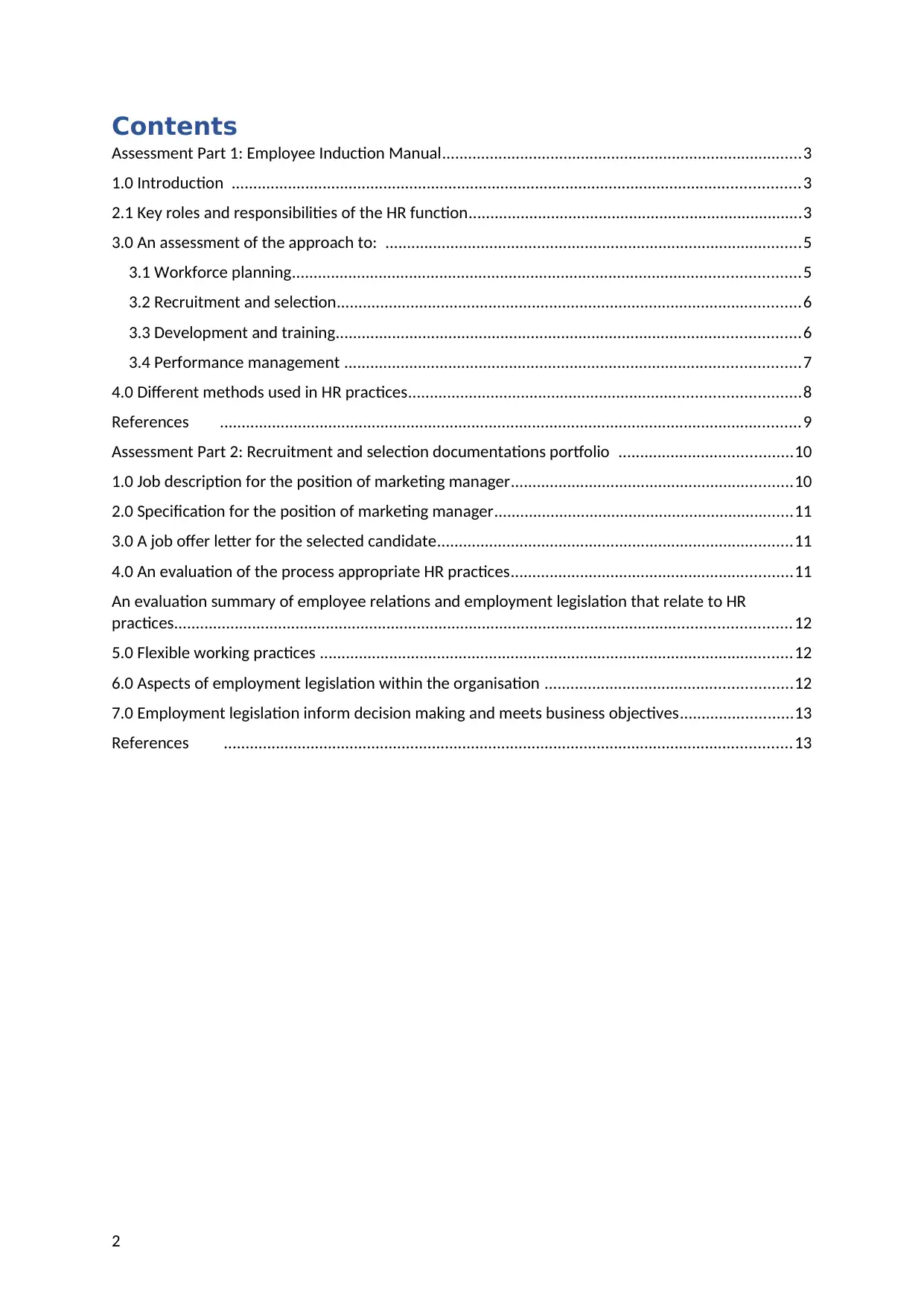
Contents
Assessment Part 1: Employee Induction Manual...................................................................................3
1.0 Introduction ...................................................................................................................................3
2.1 Key roles and responsibilities of the HR function.............................................................................3
3.0 An assessment of the approach to: ................................................................................................5
3.1 Workforce planning.....................................................................................................................5
3.2 Recruitment and selection...........................................................................................................6
3.3 Development and training...........................................................................................................6
3.4 Performance management .........................................................................................................7
4.0 Different methods used in HR practices..........................................................................................8
References ......................................................................................................................................9
Assessment Part 2: Recruitment and selection documentations portfolio ........................................10
1.0 Job description for the position of marketing manager.................................................................10
2.0 Specification for the position of marketing manager.....................................................................11
3.0 A job offer letter for the selected candidate..................................................................................11
4.0 An evaluation of the process appropriate HR practices.................................................................11
An evaluation summary of employee relations and employment legislation that relate to HR
practices..............................................................................................................................................12
5.0 Flexible working practices .............................................................................................................12
6.0 Aspects of employment legislation within the organisation .........................................................12
7.0 Employment legislation inform decision making and meets business objectives..........................13
References ...................................................................................................................................13
2
Assessment Part 1: Employee Induction Manual...................................................................................3
1.0 Introduction ...................................................................................................................................3
2.1 Key roles and responsibilities of the HR function.............................................................................3
3.0 An assessment of the approach to: ................................................................................................5
3.1 Workforce planning.....................................................................................................................5
3.2 Recruitment and selection...........................................................................................................6
3.3 Development and training...........................................................................................................6
3.4 Performance management .........................................................................................................7
4.0 Different methods used in HR practices..........................................................................................8
References ......................................................................................................................................9
Assessment Part 2: Recruitment and selection documentations portfolio ........................................10
1.0 Job description for the position of marketing manager.................................................................10
2.0 Specification for the position of marketing manager.....................................................................11
3.0 A job offer letter for the selected candidate..................................................................................11
4.0 An evaluation of the process appropriate HR practices.................................................................11
An evaluation summary of employee relations and employment legislation that relate to HR
practices..............................................................................................................................................12
5.0 Flexible working practices .............................................................................................................12
6.0 Aspects of employment legislation within the organisation .........................................................12
7.0 Employment legislation inform decision making and meets business objectives..........................13
References ...................................................................................................................................13
2
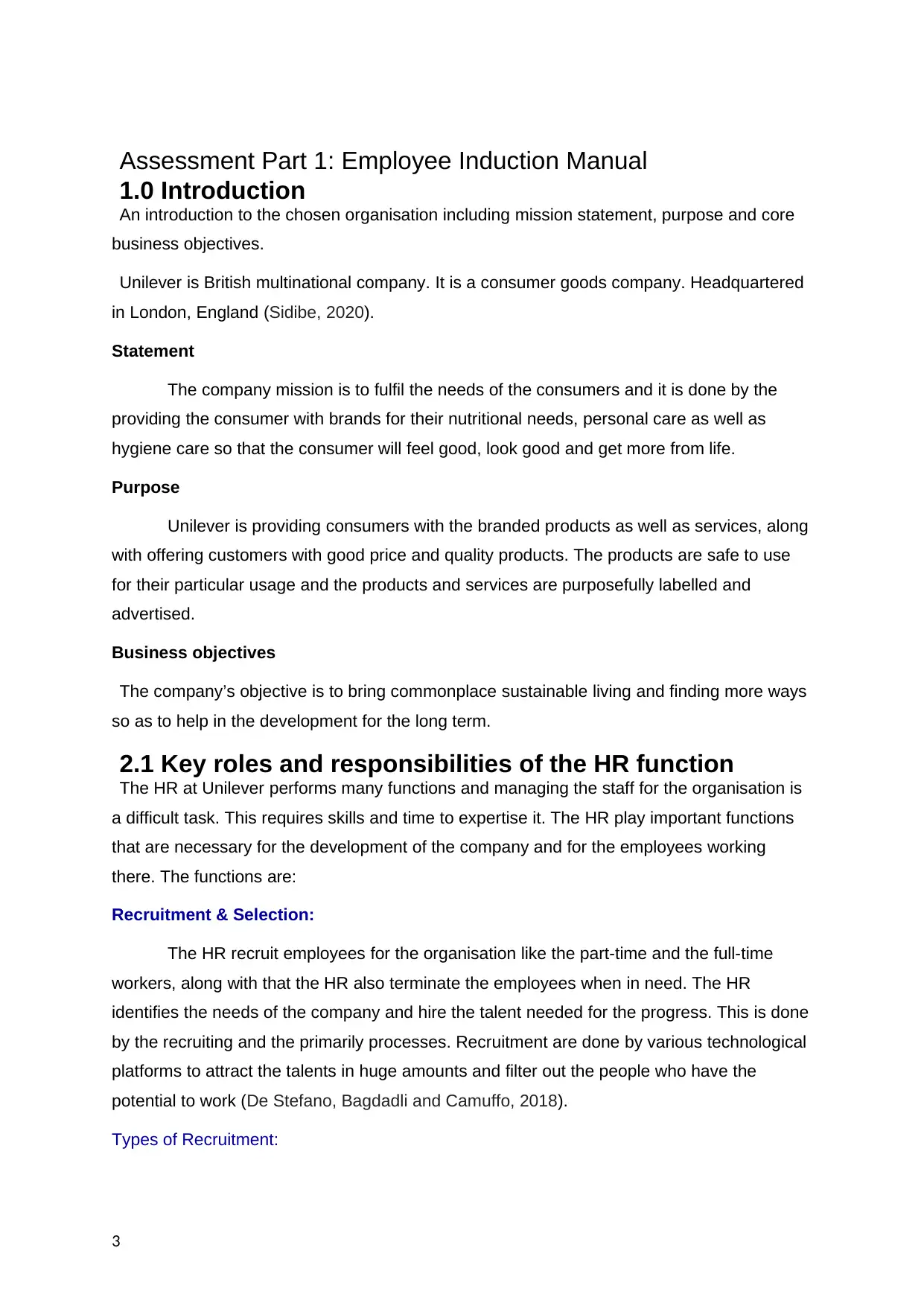
Assessment Part 1: Employee Induction Manual
1.0 Introduction
An introduction to the chosen organisation including mission statement, purpose and core
business objectives.
Unilever is British multinational company. It is a consumer goods company. Headquartered
in London, England (Sidibe, 2020).
Statement
The company mission is to fulfil the needs of the consumers and it is done by the
providing the consumer with brands for their nutritional needs, personal care as well as
hygiene care so that the consumer will feel good, look good and get more from life.
Purpose
Unilever is providing consumers with the branded products as well as services, along
with offering customers with good price and quality products. The products are safe to use
for their particular usage and the products and services are purposefully labelled and
advertised.
Business objectives
The company’s objective is to bring commonplace sustainable living and finding more ways
so as to help in the development for the long term.
2.1 Key roles and responsibilities of the HR function
The HR at Unilever performs many functions and managing the staff for the organisation is
a difficult task. This requires skills and time to expertise it. The HR play important functions
that are necessary for the development of the company and for the employees working
there. The functions are:
Recruitment & Selection:
The HR recruit employees for the organisation like the part-time and the full-time
workers, along with that the HR also terminate the employees when in need. The HR
identifies the needs of the company and hire the talent needed for the progress. This is done
by the recruiting and the primarily processes. Recruitment are done by various technological
platforms to attract the talents in huge amounts and filter out the people who have the
potential to work (De Stefano, Bagdadli and Camuffo, 2018).
Types of Recruitment:
3
1.0 Introduction
An introduction to the chosen organisation including mission statement, purpose and core
business objectives.
Unilever is British multinational company. It is a consumer goods company. Headquartered
in London, England (Sidibe, 2020).
Statement
The company mission is to fulfil the needs of the consumers and it is done by the
providing the consumer with brands for their nutritional needs, personal care as well as
hygiene care so that the consumer will feel good, look good and get more from life.
Purpose
Unilever is providing consumers with the branded products as well as services, along
with offering customers with good price and quality products. The products are safe to use
for their particular usage and the products and services are purposefully labelled and
advertised.
Business objectives
The company’s objective is to bring commonplace sustainable living and finding more ways
so as to help in the development for the long term.
2.1 Key roles and responsibilities of the HR function
The HR at Unilever performs many functions and managing the staff for the organisation is
a difficult task. This requires skills and time to expertise it. The HR play important functions
that are necessary for the development of the company and for the employees working
there. The functions are:
Recruitment & Selection:
The HR recruit employees for the organisation like the part-time and the full-time
workers, along with that the HR also terminate the employees when in need. The HR
identifies the needs of the company and hire the talent needed for the progress. This is done
by the recruiting and the primarily processes. Recruitment are done by various technological
platforms to attract the talents in huge amounts and filter out the people who have the
potential to work (De Stefano, Bagdadli and Camuffo, 2018).
Types of Recruitment:
3
⊘ This is a preview!⊘
Do you want full access?
Subscribe today to unlock all pages.

Trusted by 1+ million students worldwide
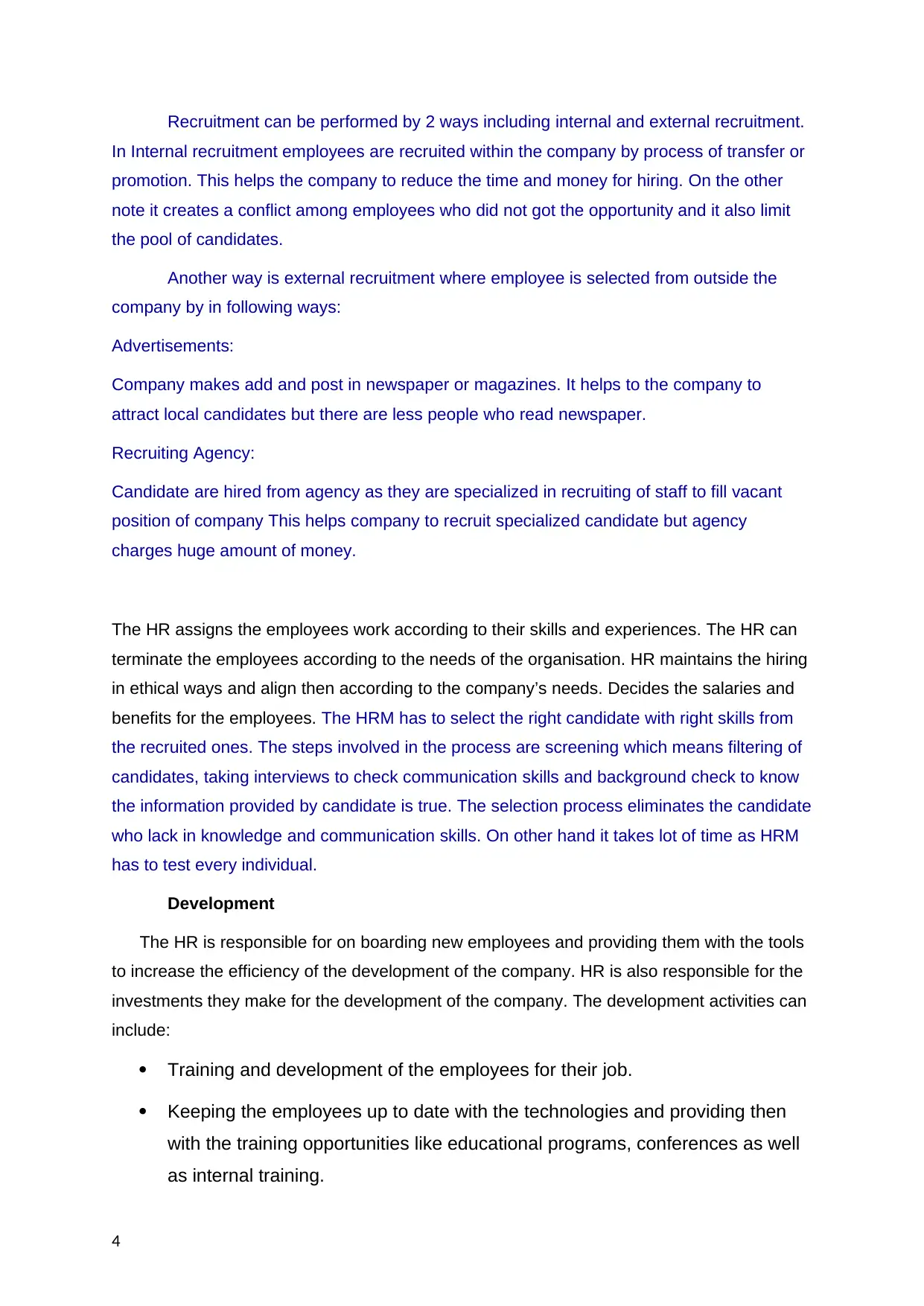
Recruitment can be performed by 2 ways including internal and external recruitment.
In Internal recruitment employees are recruited within the company by process of transfer or
promotion. This helps the company to reduce the time and money for hiring. On the other
note it creates a conflict among employees who did not got the opportunity and it also limit
the pool of candidates.
Another way is external recruitment where employee is selected from outside the
company by in following ways:
Advertisements:
Company makes add and post in newspaper or magazines. It helps to the company to
attract local candidates but there are less people who read newspaper.
Recruiting Agency:
Candidate are hired from agency as they are specialized in recruiting of staff to fill vacant
position of company This helps company to recruit specialized candidate but agency
charges huge amount of money.
The HR assigns the employees work according to their skills and experiences. The HR can
terminate the employees according to the needs of the organisation. HR maintains the hiring
in ethical ways and align then according to the company’s needs. Decides the salaries and
benefits for the employees. The HRM has to select the right candidate with right skills from
the recruited ones. The steps involved in the process are screening which means filtering of
candidates, taking interviews to check communication skills and background check to know
the information provided by candidate is true. The selection process eliminates the candidate
who lack in knowledge and communication skills. On other hand it takes lot of time as HRM
has to test every individual.
Development
The HR is responsible for on boarding new employees and providing them with the tools
to increase the efficiency of the development of the company. HR is also responsible for the
investments they make for the development of the company. The development activities can
include:
Training and development of the employees for their job.
Keeping the employees up to date with the technologies and providing then
with the training opportunities like educational programs, conferences as well
as internal training.
4
In Internal recruitment employees are recruited within the company by process of transfer or
promotion. This helps the company to reduce the time and money for hiring. On the other
note it creates a conflict among employees who did not got the opportunity and it also limit
the pool of candidates.
Another way is external recruitment where employee is selected from outside the
company by in following ways:
Advertisements:
Company makes add and post in newspaper or magazines. It helps to the company to
attract local candidates but there are less people who read newspaper.
Recruiting Agency:
Candidate are hired from agency as they are specialized in recruiting of staff to fill vacant
position of company This helps company to recruit specialized candidate but agency
charges huge amount of money.
The HR assigns the employees work according to their skills and experiences. The HR can
terminate the employees according to the needs of the organisation. HR maintains the hiring
in ethical ways and align then according to the company’s needs. Decides the salaries and
benefits for the employees. The HRM has to select the right candidate with right skills from
the recruited ones. The steps involved in the process are screening which means filtering of
candidates, taking interviews to check communication skills and background check to know
the information provided by candidate is true. The selection process eliminates the candidate
who lack in knowledge and communication skills. On other hand it takes lot of time as HRM
has to test every individual.
Development
The HR is responsible for on boarding new employees and providing them with the tools
to increase the efficiency of the development of the company. HR is also responsible for the
investments they make for the development of the company. The development activities can
include:
Training and development of the employees for their job.
Keeping the employees up to date with the technologies and providing then
with the training opportunities like educational programs, conferences as well
as internal training.
4
Paraphrase This Document
Need a fresh take? Get an instant paraphrase of this document with our AI Paraphraser
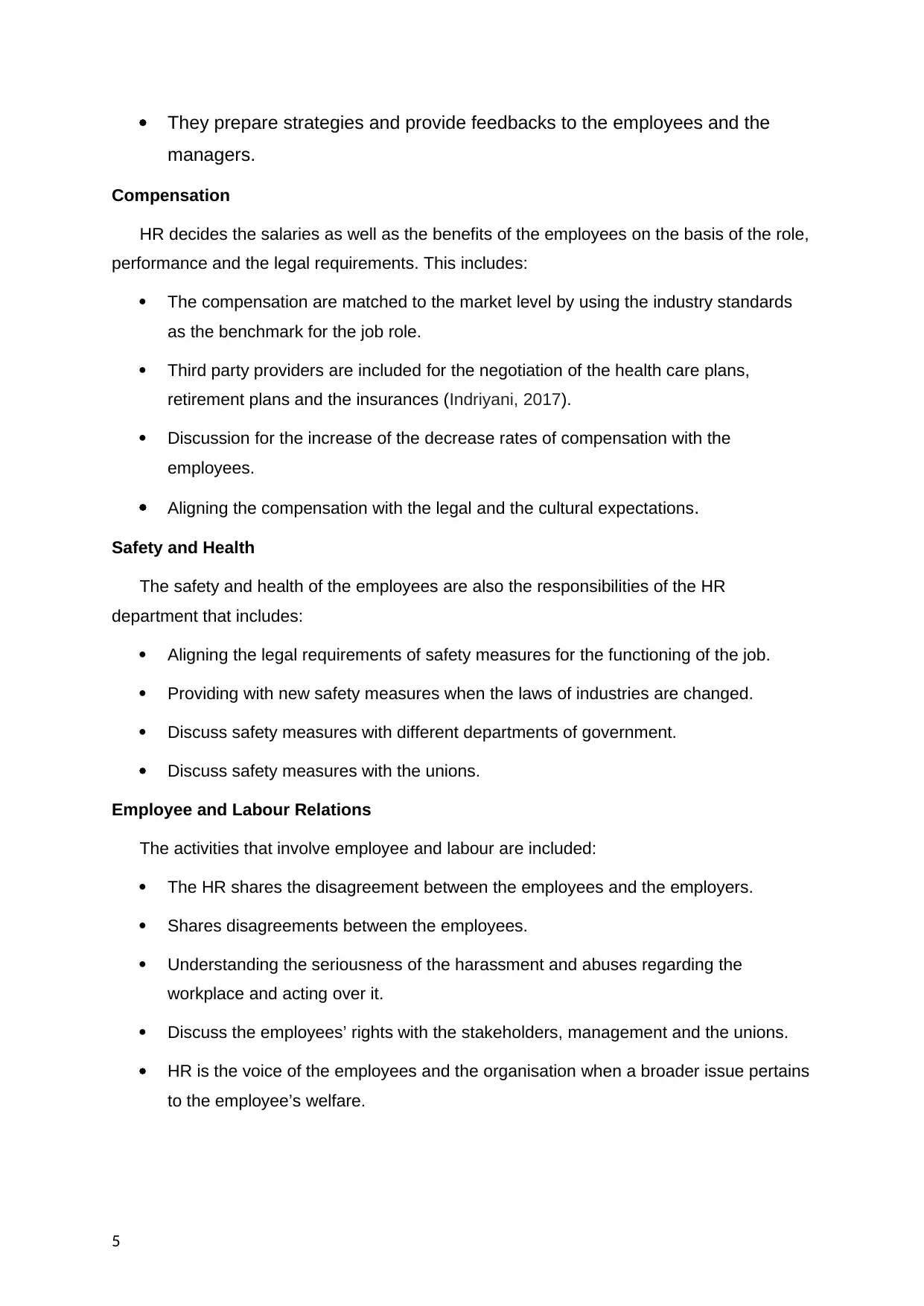
They prepare strategies and provide feedbacks to the employees and the
managers.
Compensation
HR decides the salaries as well as the benefits of the employees on the basis of the role,
performance and the legal requirements. This includes:
The compensation are matched to the market level by using the industry standards
as the benchmark for the job role.
Third party providers are included for the negotiation of the health care plans,
retirement plans and the insurances (Indriyani, 2017).
Discussion for the increase of the decrease rates of compensation with the
employees.
Aligning the compensation with the legal and the cultural expectations.
Safety and Health
The safety and health of the employees are also the responsibilities of the HR
department that includes:
Aligning the legal requirements of safety measures for the functioning of the job.
Providing with new safety measures when the laws of industries are changed.
Discuss safety measures with different departments of government.
Discuss safety measures with the unions.
Employee and Labour Relations
The activities that involve employee and labour are included:
The HR shares the disagreement between the employees and the employers.
Shares disagreements between the employees.
Understanding the seriousness of the harassment and abuses regarding the
workplace and acting over it.
Discuss the employees’ rights with the stakeholders, management and the unions.
HR is the voice of the employees and the organisation when a broader issue pertains
to the employee’s welfare.
5
managers.
Compensation
HR decides the salaries as well as the benefits of the employees on the basis of the role,
performance and the legal requirements. This includes:
The compensation are matched to the market level by using the industry standards
as the benchmark for the job role.
Third party providers are included for the negotiation of the health care plans,
retirement plans and the insurances (Indriyani, 2017).
Discussion for the increase of the decrease rates of compensation with the
employees.
Aligning the compensation with the legal and the cultural expectations.
Safety and Health
The safety and health of the employees are also the responsibilities of the HR
department that includes:
Aligning the legal requirements of safety measures for the functioning of the job.
Providing with new safety measures when the laws of industries are changed.
Discuss safety measures with different departments of government.
Discuss safety measures with the unions.
Employee and Labour Relations
The activities that involve employee and labour are included:
The HR shares the disagreement between the employees and the employers.
Shares disagreements between the employees.
Understanding the seriousness of the harassment and abuses regarding the
workplace and acting over it.
Discuss the employees’ rights with the stakeholders, management and the unions.
HR is the voice of the employees and the organisation when a broader issue pertains
to the employee’s welfare.
5
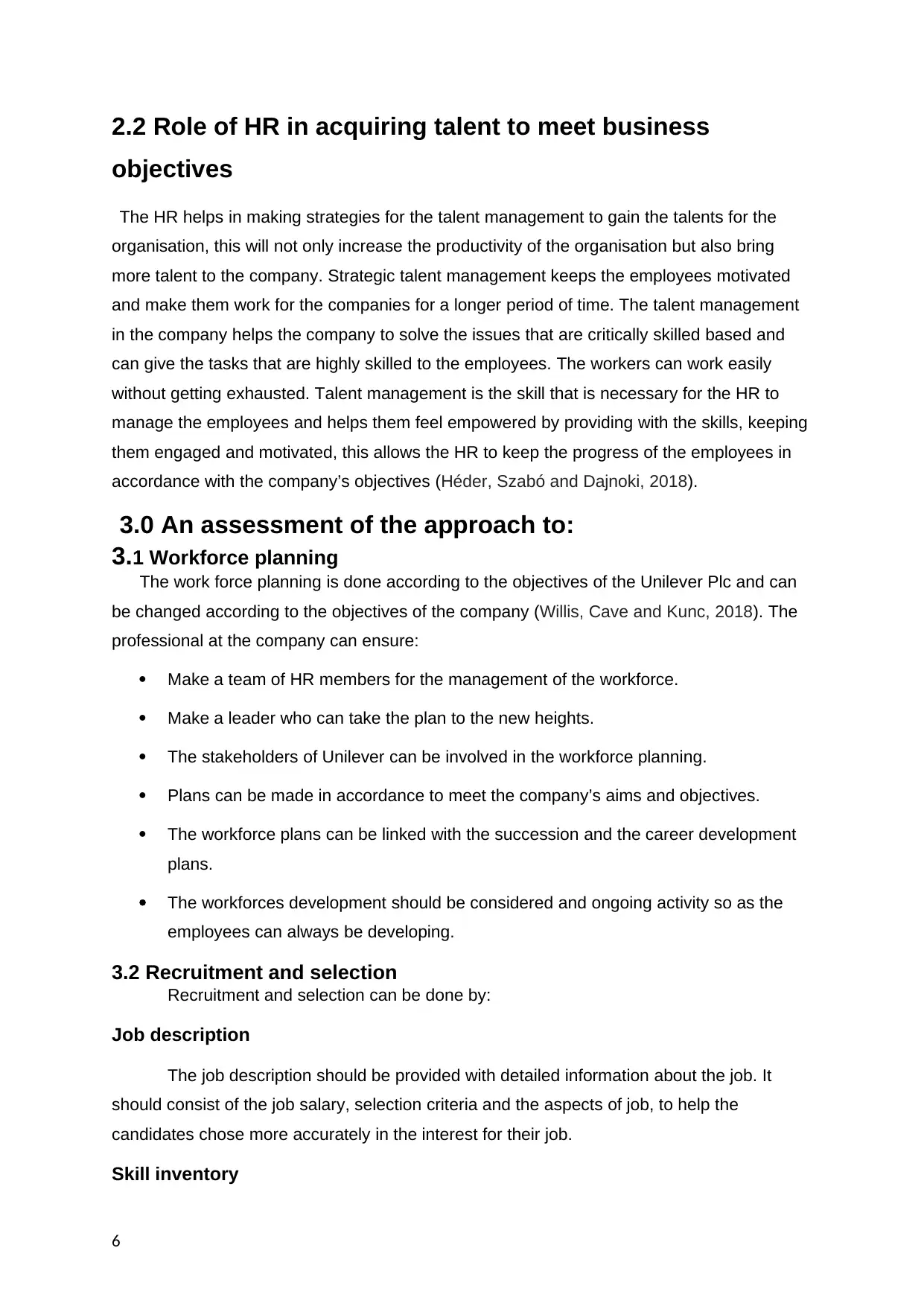
2.2 Role of HR in acquiring talent to meet business
objectives
The HR helps in making strategies for the talent management to gain the talents for the
organisation, this will not only increase the productivity of the organisation but also bring
more talent to the company. Strategic talent management keeps the employees motivated
and make them work for the companies for a longer period of time. The talent management
in the company helps the company to solve the issues that are critically skilled based and
can give the tasks that are highly skilled to the employees. The workers can work easily
without getting exhausted. Talent management is the skill that is necessary for the HR to
manage the employees and helps them feel empowered by providing with the skills, keeping
them engaged and motivated, this allows the HR to keep the progress of the employees in
accordance with the company’s objectives (Héder, Szabó and Dajnoki, 2018).
3.0 An assessment of the approach to:
3.1 Workforce planning
The work force planning is done according to the objectives of the Unilever Plc and can
be changed according to the objectives of the company (Willis, Cave and Kunc, 2018). The
professional at the company can ensure:
Make a team of HR members for the management of the workforce.
Make a leader who can take the plan to the new heights.
The stakeholders of Unilever can be involved in the workforce planning.
Plans can be made in accordance to meet the company’s aims and objectives.
The workforce plans can be linked with the succession and the career development
plans.
The workforces development should be considered and ongoing activity so as the
employees can always be developing.
3.2 Recruitment and selection
Recruitment and selection can be done by:
Job description
The job description should be provided with detailed information about the job. It
should consist of the job salary, selection criteria and the aspects of job, to help the
candidates chose more accurately in the interest for their job.
Skill inventory
6
objectives
The HR helps in making strategies for the talent management to gain the talents for the
organisation, this will not only increase the productivity of the organisation but also bring
more talent to the company. Strategic talent management keeps the employees motivated
and make them work for the companies for a longer period of time. The talent management
in the company helps the company to solve the issues that are critically skilled based and
can give the tasks that are highly skilled to the employees. The workers can work easily
without getting exhausted. Talent management is the skill that is necessary for the HR to
manage the employees and helps them feel empowered by providing with the skills, keeping
them engaged and motivated, this allows the HR to keep the progress of the employees in
accordance with the company’s objectives (Héder, Szabó and Dajnoki, 2018).
3.0 An assessment of the approach to:
3.1 Workforce planning
The work force planning is done according to the objectives of the Unilever Plc and can
be changed according to the objectives of the company (Willis, Cave and Kunc, 2018). The
professional at the company can ensure:
Make a team of HR members for the management of the workforce.
Make a leader who can take the plan to the new heights.
The stakeholders of Unilever can be involved in the workforce planning.
Plans can be made in accordance to meet the company’s aims and objectives.
The workforce plans can be linked with the succession and the career development
plans.
The workforces development should be considered and ongoing activity so as the
employees can always be developing.
3.2 Recruitment and selection
Recruitment and selection can be done by:
Job description
The job description should be provided with detailed information about the job. It
should consist of the job salary, selection criteria and the aspects of job, to help the
candidates chose more accurately in the interest for their job.
Skill inventory
6
⊘ This is a preview!⊘
Do you want full access?
Subscribe today to unlock all pages.

Trusted by 1+ million students worldwide
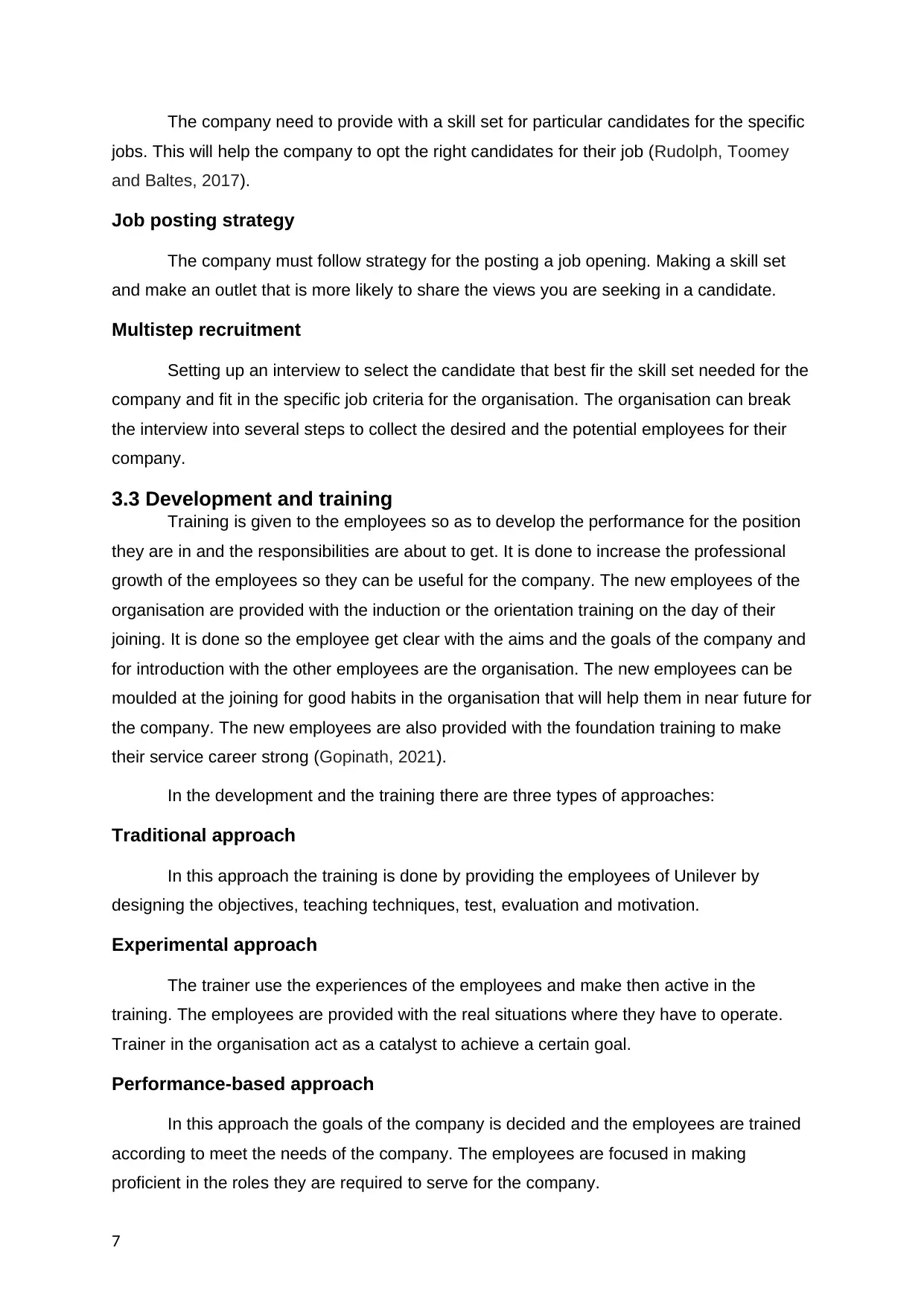
The company need to provide with a skill set for particular candidates for the specific
jobs. This will help the company to opt the right candidates for their job (Rudolph, Toomey
and Baltes, 2017).
Job posting strategy
The company must follow strategy for the posting a job opening. Making a skill set
and make an outlet that is more likely to share the views you are seeking in a candidate.
Multistep recruitment
Setting up an interview to select the candidate that best fir the skill set needed for the
company and fit in the specific job criteria for the organisation. The organisation can break
the interview into several steps to collect the desired and the potential employees for their
company.
3.3 Development and training
Training is given to the employees so as to develop the performance for the position
they are in and the responsibilities are about to get. It is done to increase the professional
growth of the employees so they can be useful for the company. The new employees of the
organisation are provided with the induction or the orientation training on the day of their
joining. It is done so the employee get clear with the aims and the goals of the company and
for introduction with the other employees are the organisation. The new employees can be
moulded at the joining for good habits in the organisation that will help them in near future for
the company. The new employees are also provided with the foundation training to make
their service career strong (Gopinath, 2021).
In the development and the training there are three types of approaches:
Traditional approach
In this approach the training is done by providing the employees of Unilever by
designing the objectives, teaching techniques, test, evaluation and motivation.
Experimental approach
The trainer use the experiences of the employees and make then active in the
training. The employees are provided with the real situations where they have to operate.
Trainer in the organisation act as a catalyst to achieve a certain goal.
Performance-based approach
In this approach the goals of the company is decided and the employees are trained
according to meet the needs of the company. The employees are focused in making
proficient in the roles they are required to serve for the company.
7
jobs. This will help the company to opt the right candidates for their job (Rudolph, Toomey
and Baltes, 2017).
Job posting strategy
The company must follow strategy for the posting a job opening. Making a skill set
and make an outlet that is more likely to share the views you are seeking in a candidate.
Multistep recruitment
Setting up an interview to select the candidate that best fir the skill set needed for the
company and fit in the specific job criteria for the organisation. The organisation can break
the interview into several steps to collect the desired and the potential employees for their
company.
3.3 Development and training
Training is given to the employees so as to develop the performance for the position
they are in and the responsibilities are about to get. It is done to increase the professional
growth of the employees so they can be useful for the company. The new employees of the
organisation are provided with the induction or the orientation training on the day of their
joining. It is done so the employee get clear with the aims and the goals of the company and
for introduction with the other employees are the organisation. The new employees can be
moulded at the joining for good habits in the organisation that will help them in near future for
the company. The new employees are also provided with the foundation training to make
their service career strong (Gopinath, 2021).
In the development and the training there are three types of approaches:
Traditional approach
In this approach the training is done by providing the employees of Unilever by
designing the objectives, teaching techniques, test, evaluation and motivation.
Experimental approach
The trainer use the experiences of the employees and make then active in the
training. The employees are provided with the real situations where they have to operate.
Trainer in the organisation act as a catalyst to achieve a certain goal.
Performance-based approach
In this approach the goals of the company is decided and the employees are trained
according to meet the needs of the company. The employees are focused in making
proficient in the roles they are required to serve for the company.
7
Paraphrase This Document
Need a fresh take? Get an instant paraphrase of this document with our AI Paraphraser
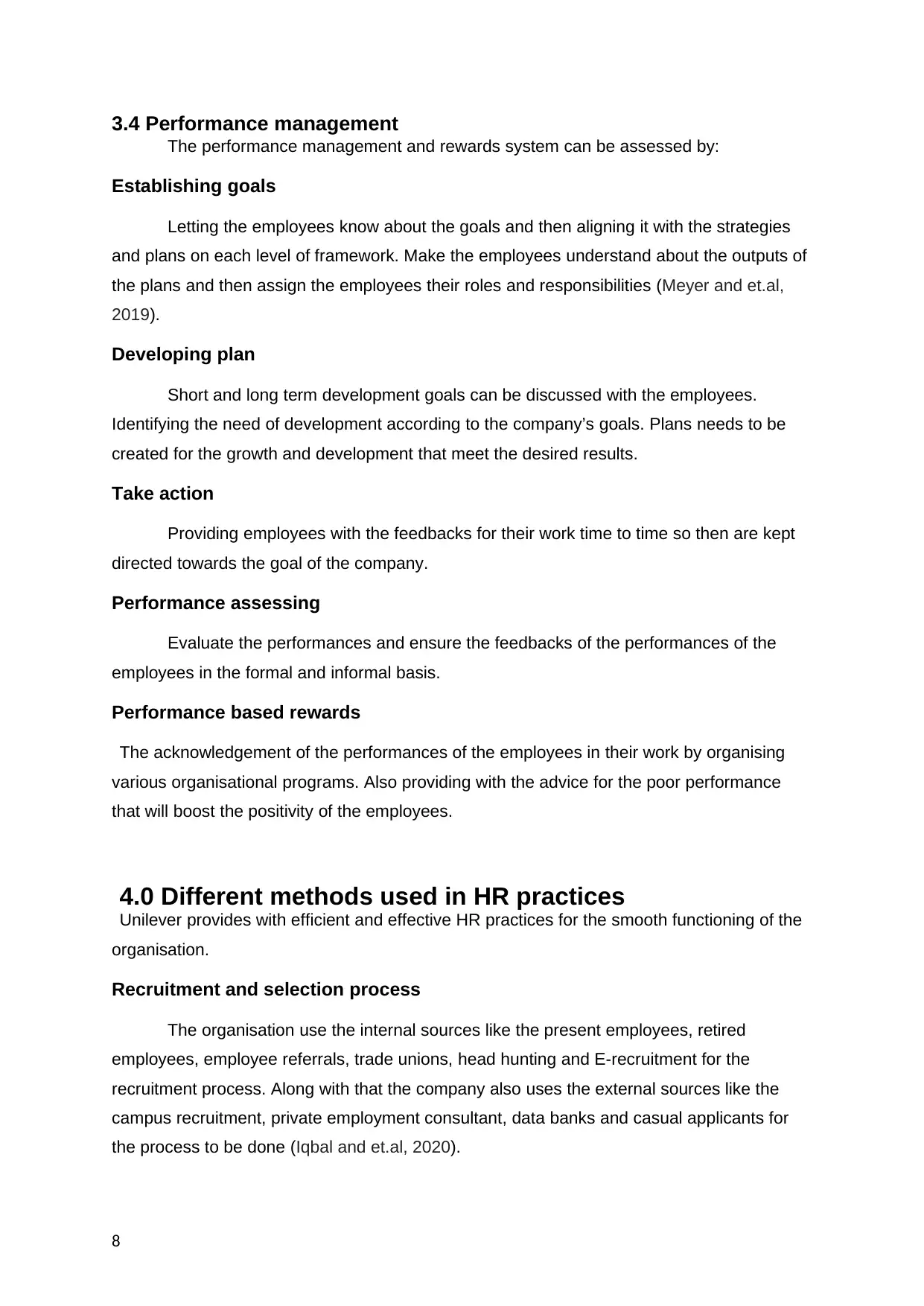
3.4 Performance management
The performance management and rewards system can be assessed by:
Establishing goals
Letting the employees know about the goals and then aligning it with the strategies
and plans on each level of framework. Make the employees understand about the outputs of
the plans and then assign the employees their roles and responsibilities (Meyer and et.al,
2019).
Developing plan
Short and long term development goals can be discussed with the employees.
Identifying the need of development according to the company’s goals. Plans needs to be
created for the growth and development that meet the desired results.
Take action
Providing employees with the feedbacks for their work time to time so then are kept
directed towards the goal of the company.
Performance assessing
Evaluate the performances and ensure the feedbacks of the performances of the
employees in the formal and informal basis.
Performance based rewards
The acknowledgement of the performances of the employees in their work by organising
various organisational programs. Also providing with the advice for the poor performance
that will boost the positivity of the employees.
4.0 Different methods used in HR practices
Unilever provides with efficient and effective HR practices for the smooth functioning of the
organisation.
Recruitment and selection process
The organisation use the internal sources like the present employees, retired
employees, employee referrals, trade unions, head hunting and E-recruitment for the
recruitment process. Along with that the company also uses the external sources like the
campus recruitment, private employment consultant, data banks and casual applicants for
the process to be done (Iqbal and et.al, 2020).
8
The performance management and rewards system can be assessed by:
Establishing goals
Letting the employees know about the goals and then aligning it with the strategies
and plans on each level of framework. Make the employees understand about the outputs of
the plans and then assign the employees their roles and responsibilities (Meyer and et.al,
2019).
Developing plan
Short and long term development goals can be discussed with the employees.
Identifying the need of development according to the company’s goals. Plans needs to be
created for the growth and development that meet the desired results.
Take action
Providing employees with the feedbacks for their work time to time so then are kept
directed towards the goal of the company.
Performance assessing
Evaluate the performances and ensure the feedbacks of the performances of the
employees in the formal and informal basis.
Performance based rewards
The acknowledgement of the performances of the employees in their work by organising
various organisational programs. Also providing with the advice for the poor performance
that will boost the positivity of the employees.
4.0 Different methods used in HR practices
Unilever provides with efficient and effective HR practices for the smooth functioning of the
organisation.
Recruitment and selection process
The organisation use the internal sources like the present employees, retired
employees, employee referrals, trade unions, head hunting and E-recruitment for the
recruitment process. Along with that the company also uses the external sources like the
campus recruitment, private employment consultant, data banks and casual applicants for
the process to be done (Iqbal and et.al, 2020).
8
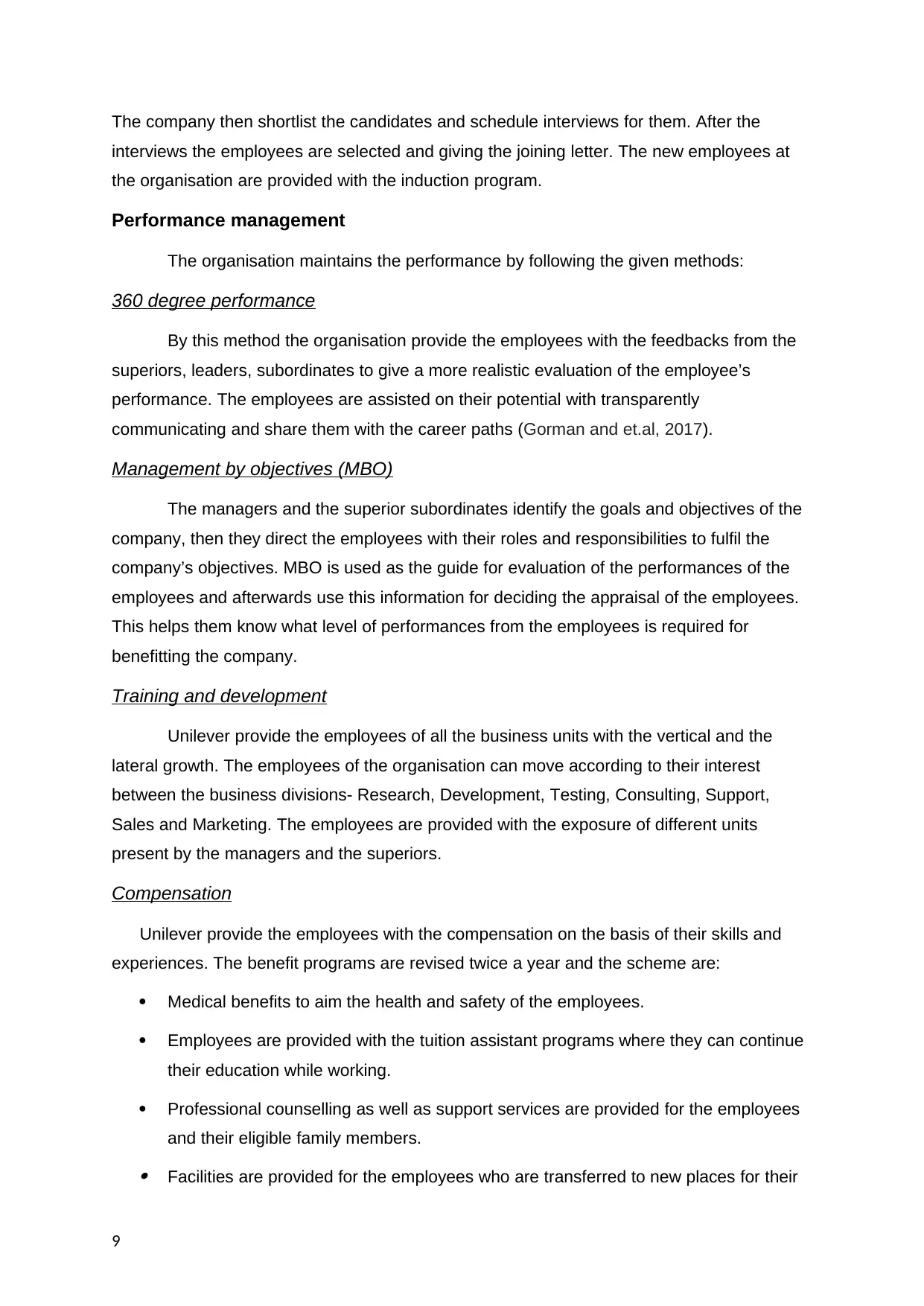
The company then shortlist the candidates and schedule interviews for them. After the
interviews the employees are selected and giving the joining letter. The new employees at
the organisation are provided with the induction program.
Performance management
The organisation maintains the performance by following the given methods:
360 degree performance
By this method the organisation provide the employees with the feedbacks from the
superiors, leaders, subordinates to give a more realistic evaluation of the employee’s
performance. The employees are assisted on their potential with transparently
communicating and share them with the career paths (Gorman and et.al, 2017).
Management by objectives (MBO)
The managers and the superior subordinates identify the goals and objectives of the
company, then they direct the employees with their roles and responsibilities to fulfil the
company’s objectives. MBO is used as the guide for evaluation of the performances of the
employees and afterwards use this information for deciding the appraisal of the employees.
This helps them know what level of performances from the employees is required for
benefitting the company.
Training and development
Unilever provide the employees of all the business units with the vertical and the
lateral growth. The employees of the organisation can move according to their interest
between the business divisions- Research, Development, Testing, Consulting, Support,
Sales and Marketing. The employees are provided with the exposure of different units
present by the managers and the superiors.
Compensation
Unilever provide the employees with the compensation on the basis of their skills and
experiences. The benefit programs are revised twice a year and the scheme are:
Medical benefits to aim the health and safety of the employees.
Employees are provided with the tuition assistant programs where they can continue
their education while working.
Professional counselling as well as support services are provided for the employees
and their eligible family members. Facilities are provided for the employees who are transferred to new places for their
9
interviews the employees are selected and giving the joining letter. The new employees at
the organisation are provided with the induction program.
Performance management
The organisation maintains the performance by following the given methods:
360 degree performance
By this method the organisation provide the employees with the feedbacks from the
superiors, leaders, subordinates to give a more realistic evaluation of the employee’s
performance. The employees are assisted on their potential with transparently
communicating and share them with the career paths (Gorman and et.al, 2017).
Management by objectives (MBO)
The managers and the superior subordinates identify the goals and objectives of the
company, then they direct the employees with their roles and responsibilities to fulfil the
company’s objectives. MBO is used as the guide for evaluation of the performances of the
employees and afterwards use this information for deciding the appraisal of the employees.
This helps them know what level of performances from the employees is required for
benefitting the company.
Training and development
Unilever provide the employees of all the business units with the vertical and the
lateral growth. The employees of the organisation can move according to their interest
between the business divisions- Research, Development, Testing, Consulting, Support,
Sales and Marketing. The employees are provided with the exposure of different units
present by the managers and the superiors.
Compensation
Unilever provide the employees with the compensation on the basis of their skills and
experiences. The benefit programs are revised twice a year and the scheme are:
Medical benefits to aim the health and safety of the employees.
Employees are provided with the tuition assistant programs where they can continue
their education while working.
Professional counselling as well as support services are provided for the employees
and their eligible family members. Facilities are provided for the employees who are transferred to new places for their
9
⊘ This is a preview!⊘
Do you want full access?
Subscribe today to unlock all pages.

Trusted by 1+ million students worldwide
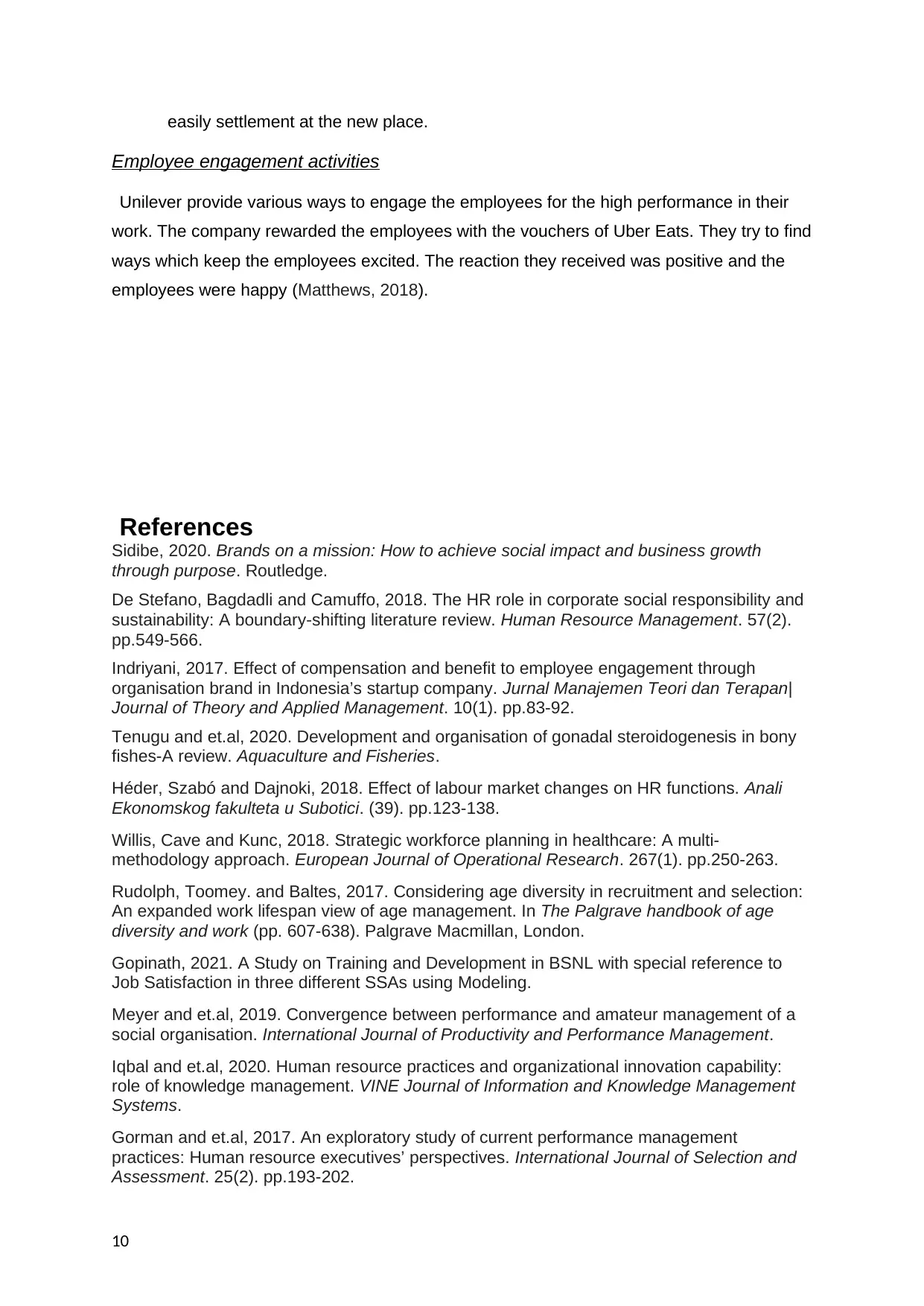
easily settlement at the new place.
Employee engagement activities
Unilever provide various ways to engage the employees for the high performance in their
work. The company rewarded the employees with the vouchers of Uber Eats. They try to find
ways which keep the employees excited. The reaction they received was positive and the
employees were happy (Matthews, 2018).
References
Sidibe, 2020. Brands on a mission: How to achieve social impact and business growth
through purpose. Routledge.
De Stefano, Bagdadli and Camuffo, 2018. The HR role in corporate social responsibility and
sustainability: A boundary‐shifting literature review. Human Resource Management. 57(2).
pp.549-566.
Indriyani, 2017. Effect of compensation and benefit to employee engagement through
organisation brand in Indonesia’s startup company. Jurnal Manajemen Teori dan Terapan|
Journal of Theory and Applied Management. 10(1). pp.83-92.
Tenugu and et.al, 2020. Development and organisation of gonadal steroidogenesis in bony
fishes-A review. Aquaculture and Fisheries.
Héder, Szabó and Dajnoki, 2018. Effect of labour market changes on HR functions. Anali
Ekonomskog fakulteta u Subotici. (39). pp.123-138.
Willis, Cave and Kunc, 2018. Strategic workforce planning in healthcare: A multi-
methodology approach. European Journal of Operational Research. 267(1). pp.250-263.
Rudolph, Toomey. and Baltes, 2017. Considering age diversity in recruitment and selection:
An expanded work lifespan view of age management. In The Palgrave handbook of age
diversity and work (pp. 607-638). Palgrave Macmillan, London.
Gopinath, 2021. A Study on Training and Development in BSNL with special reference to
Job Satisfaction in three different SSAs using Modeling.
Meyer and et.al, 2019. Convergence between performance and amateur management of a
social organisation. International Journal of Productivity and Performance Management.
Iqbal and et.al, 2020. Human resource practices and organizational innovation capability:
role of knowledge management. VINE Journal of Information and Knowledge Management
Systems.
Gorman and et.al, 2017. An exploratory study of current performance management
practices: Human resource executives’ perspectives. International Journal of Selection and
Assessment. 25(2). pp.193-202.
10
Employee engagement activities
Unilever provide various ways to engage the employees for the high performance in their
work. The company rewarded the employees with the vouchers of Uber Eats. They try to find
ways which keep the employees excited. The reaction they received was positive and the
employees were happy (Matthews, 2018).
References
Sidibe, 2020. Brands on a mission: How to achieve social impact and business growth
through purpose. Routledge.
De Stefano, Bagdadli and Camuffo, 2018. The HR role in corporate social responsibility and
sustainability: A boundary‐shifting literature review. Human Resource Management. 57(2).
pp.549-566.
Indriyani, 2017. Effect of compensation and benefit to employee engagement through
organisation brand in Indonesia’s startup company. Jurnal Manajemen Teori dan Terapan|
Journal of Theory and Applied Management. 10(1). pp.83-92.
Tenugu and et.al, 2020. Development and organisation of gonadal steroidogenesis in bony
fishes-A review. Aquaculture and Fisheries.
Héder, Szabó and Dajnoki, 2018. Effect of labour market changes on HR functions. Anali
Ekonomskog fakulteta u Subotici. (39). pp.123-138.
Willis, Cave and Kunc, 2018. Strategic workforce planning in healthcare: A multi-
methodology approach. European Journal of Operational Research. 267(1). pp.250-263.
Rudolph, Toomey. and Baltes, 2017. Considering age diversity in recruitment and selection:
An expanded work lifespan view of age management. In The Palgrave handbook of age
diversity and work (pp. 607-638). Palgrave Macmillan, London.
Gopinath, 2021. A Study on Training and Development in BSNL with special reference to
Job Satisfaction in three different SSAs using Modeling.
Meyer and et.al, 2019. Convergence between performance and amateur management of a
social organisation. International Journal of Productivity and Performance Management.
Iqbal and et.al, 2020. Human resource practices and organizational innovation capability:
role of knowledge management. VINE Journal of Information and Knowledge Management
Systems.
Gorman and et.al, 2017. An exploratory study of current performance management
practices: Human resource executives’ perspectives. International Journal of Selection and
Assessment. 25(2). pp.193-202.
10
Paraphrase This Document
Need a fresh take? Get an instant paraphrase of this document with our AI Paraphraser
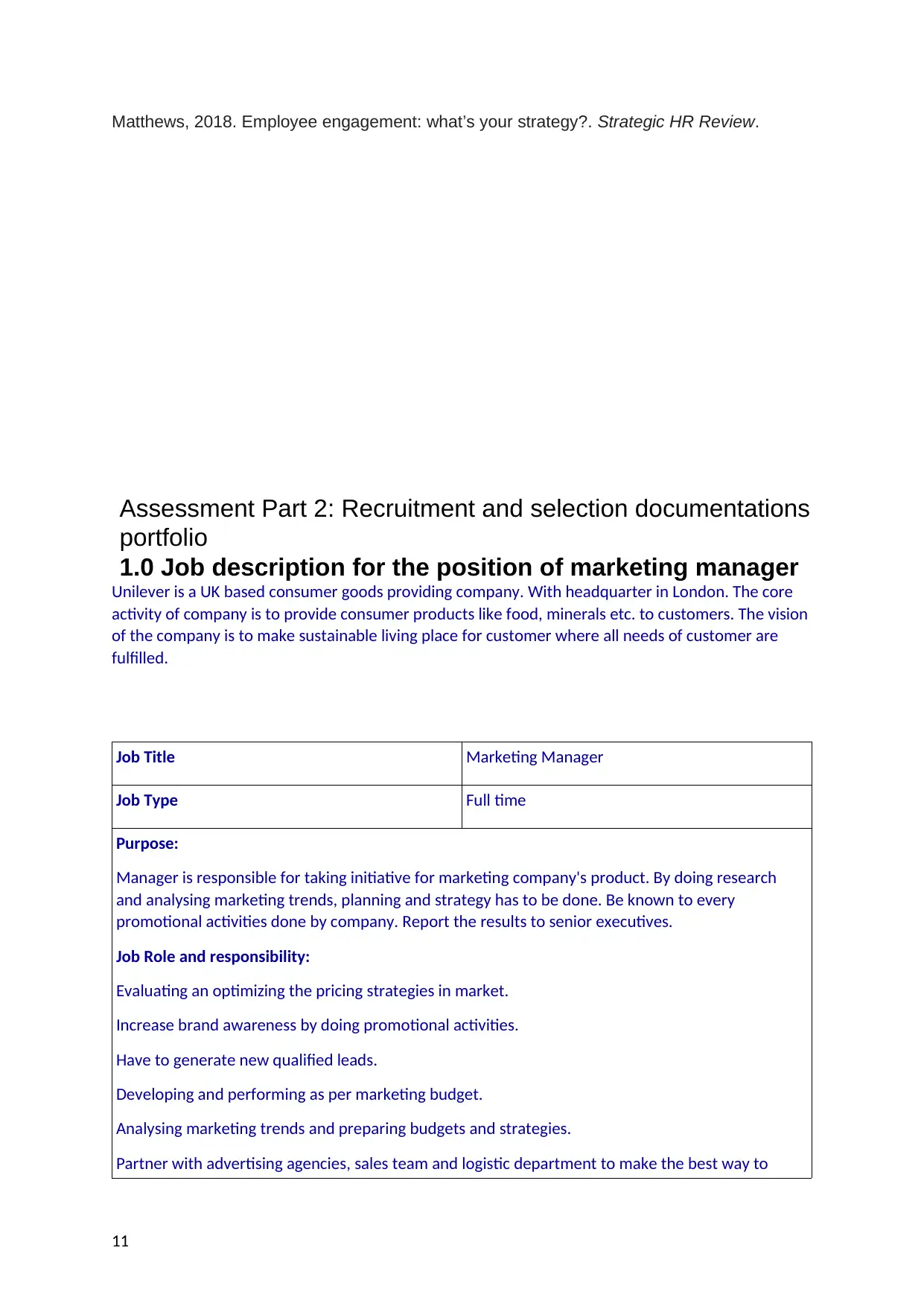
Matthews, 2018. Employee engagement: what’s your strategy?. Strategic HR Review.
Assessment Part 2: Recruitment and selection documentations
portfolio
1.0 Job description for the position of marketing manager
Unilever is a UK based consumer goods providing company. With headquarter in London. The core
activity of company is to provide consumer products like food, minerals etc. to customers. The vision
of the company is to make sustainable living place for customer where all needs of customer are
fulfilled.
Job Title Marketing Manager
Job Type Full time
Purpose:
Manager is responsible for taking initiative for marketing company's product. By doing research
and analysing marketing trends, planning and strategy has to be done. Be known to every
promotional activities done by company. Report the results to senior executives.
Job Role and responsibility:
Evaluating an optimizing the pricing strategies in market.
Increase brand awareness by doing promotional activities.
Have to generate new qualified leads.
Developing and performing as per marketing budget.
Analysing marketing trends and preparing budgets and strategies.
Partner with advertising agencies, sales team and logistic department to make the best way to
11
Assessment Part 2: Recruitment and selection documentations
portfolio
1.0 Job description for the position of marketing manager
Unilever is a UK based consumer goods providing company. With headquarter in London. The core
activity of company is to provide consumer products like food, minerals etc. to customers. The vision
of the company is to make sustainable living place for customer where all needs of customer are
fulfilled.
Job Title Marketing Manager
Job Type Full time
Purpose:
Manager is responsible for taking initiative for marketing company's product. By doing research
and analysing marketing trends, planning and strategy has to be done. Be known to every
promotional activities done by company. Report the results to senior executives.
Job Role and responsibility:
Evaluating an optimizing the pricing strategies in market.
Increase brand awareness by doing promotional activities.
Have to generate new qualified leads.
Developing and performing as per marketing budget.
Analysing marketing trends and preparing budgets and strategies.
Partner with advertising agencies, sales team and logistic department to make the best way to
11
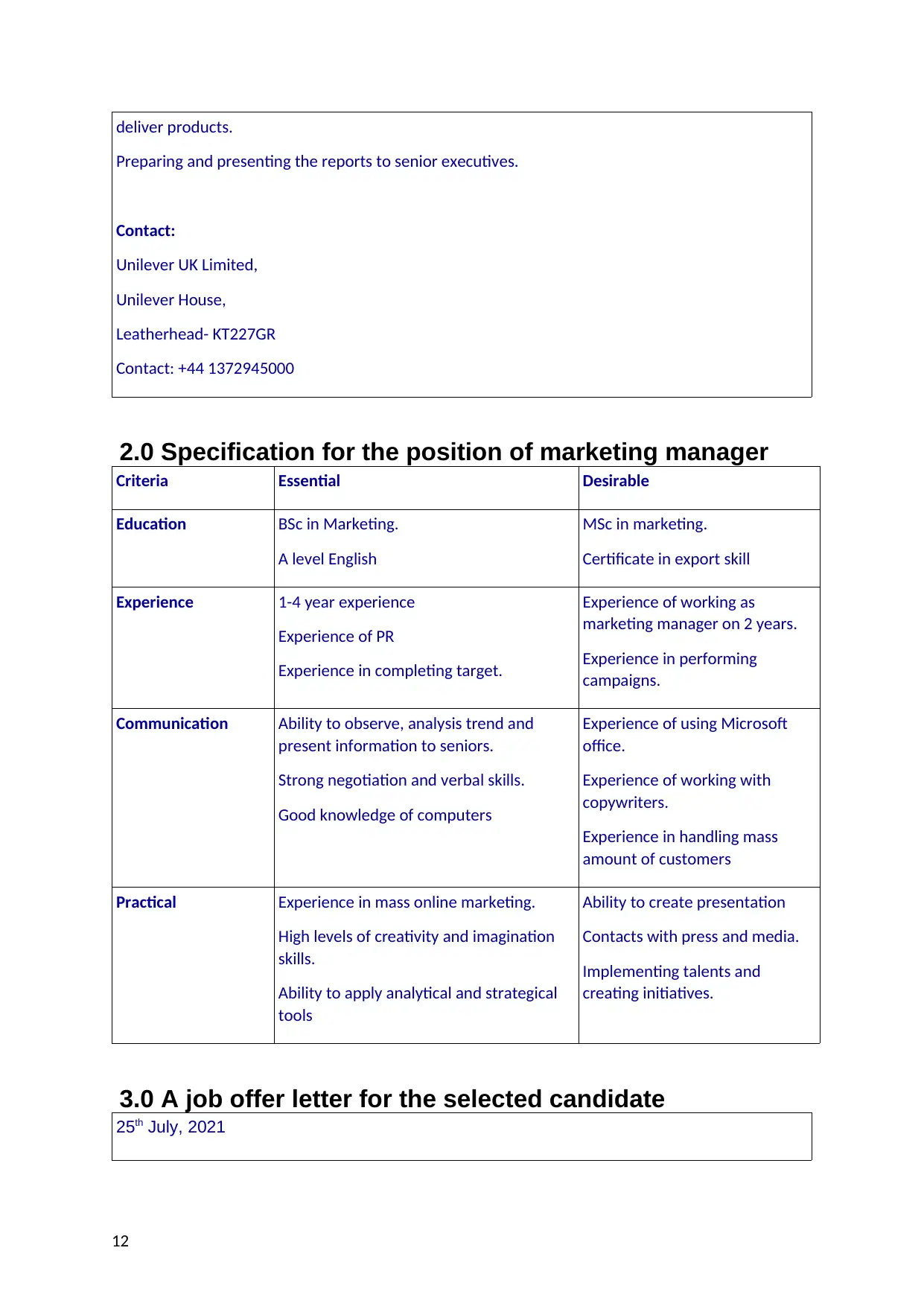
deliver products.
Preparing and presenting the reports to senior executives.
Contact:
Unilever UK Limited,
Unilever House,
Leatherhead- KT227GR
Contact: +44 1372945000
2.0 Specification for the position of marketing manager
Criteria Essential Desirable
Education BSc in Marketing.
A level English
MSc in marketing.
Certificate in export skill
Experience 1-4 year experience
Experience of PR
Experience in completing target.
Experience of working as
marketing manager on 2 years.
Experience in performing
campaigns.
Communication Ability to observe, analysis trend and
present information to seniors.
Strong negotiation and verbal skills.
Good knowledge of computers
Experience of using Microsoft
office.
Experience of working with
copywriters.
Experience in handling mass
amount of customers
Practical Experience in mass online marketing.
High levels of creativity and imagination
skills.
Ability to apply analytical and strategical
tools
Ability to create presentation
Contacts with press and media.
Implementing talents and
creating initiatives.
3.0 A job offer letter for the selected candidate
25th July, 2021
12
Preparing and presenting the reports to senior executives.
Contact:
Unilever UK Limited,
Unilever House,
Leatherhead- KT227GR
Contact: +44 1372945000
2.0 Specification for the position of marketing manager
Criteria Essential Desirable
Education BSc in Marketing.
A level English
MSc in marketing.
Certificate in export skill
Experience 1-4 year experience
Experience of PR
Experience in completing target.
Experience of working as
marketing manager on 2 years.
Experience in performing
campaigns.
Communication Ability to observe, analysis trend and
present information to seniors.
Strong negotiation and verbal skills.
Good knowledge of computers
Experience of using Microsoft
office.
Experience of working with
copywriters.
Experience in handling mass
amount of customers
Practical Experience in mass online marketing.
High levels of creativity and imagination
skills.
Ability to apply analytical and strategical
tools
Ability to create presentation
Contacts with press and media.
Implementing talents and
creating initiatives.
3.0 A job offer letter for the selected candidate
25th July, 2021
12
⊘ This is a preview!⊘
Do you want full access?
Subscribe today to unlock all pages.

Trusted by 1+ million students worldwide
1 out of 16
Related Documents
Your All-in-One AI-Powered Toolkit for Academic Success.
+13062052269
info@desklib.com
Available 24*7 on WhatsApp / Email
![[object Object]](/_next/static/media/star-bottom.7253800d.svg)
Unlock your academic potential
Copyright © 2020–2025 A2Z Services. All Rights Reserved. Developed and managed by ZUCOL.





